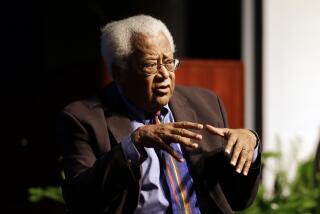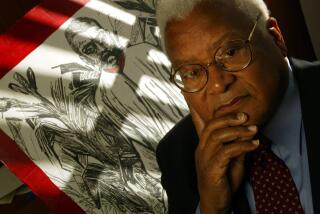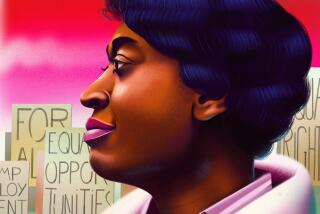Land of the Free
Across a balloon-festooned stage they walked, smiling, under a banner that read âCongratulations Class of â03,â to receive their certificates of completion of the fifth grade at Coeur DâAlene Elementary School in Venice.
In pigtails and curls and spikes and corn rows, in bow ties and suits and flowered dresses they came: Caitlyn Ahlberg, Carson De Dios, Allison Fleming (my granddaughter), Augustin Francisco, Jonas Ganzoni, E. Abraham Guerrero, Brandon Kim, LaChanique Williams and the rest. It was a mix of every hue and color and background imaginable -- a radiant rainbow of Asian, then black, then white, then Latino and so on in a widening ethnic circle.
The grinning principal, Rex Patton, had a message for the graduates: âI want to remind all of our fifth-graders here today to never, ever be content with someone elseâs definition of you. Instead, you define yourself by your own beliefs, your own truths, your own understanding of who you are and what you want to become in life.â
His words took me back in time. Forty years ago I was a reporter for Newsweek, living in the South and covering the civil rights movement. It was a time of violence, hatred, fear and despair, a time when the entire might of the white establishment was galvanized to deny exactly what the Venice principal was affirming last week: that all people have the right to define themselves and to freely pursue their own dreams and beliefs and truths.
The Supreme Court had ruled in 1954 that separate was not equal in schools, and courts were beginning to order white schools to admit blacks when I started reporting on the situation. In town after Southern town, beatings, bombings, burnings and even murders were being committed by whites to prevent ârace mixingâ in the schools.
It was ugly to watch. In Jackson, Miss., I saw cops bludgeon black parents to their knees and snatch American flags from their childrenâs hands when they marched against segregated schools and other public places. In New Orleans, I wrote about Catholic mothers, their faces contorted with rage, who screamed hate at an archbishop who ordered church schools integrated. In Albany, Ga., I saw hundreds of children and parents, all dressed in their Sunday best, arrested and jailed -- along with the Rev. Martin Luther King Jr. -- for marching for equality.
In Birmingham, Ala., I wrote about four little girls who lost their lives when their church was bombed by members of the Ku Klux Klan. Even in supposedly moderate Atlanta, I saw white mothers scream obscenities at two 8-year-old black girls who dared to arrive for enrollment, with their frightened parents, at a neighborhood elementary school.
Later in the â60s, I witnessed massive violent uprisings in Los Angeles, Chicago, Washington, Detroit, Harlem and Newark, N.J., as ghettoized blacks, and in Los Angeles, Latinos too, tried to scale the walls of apartheid that separated them from white America.
In the course of things, I got to know King pretty well. After he was assassinated in 1968, I walked beside the mule-drawn wagon that carried him to his grave.
These are the things I thought about on the placid California morning of my granddaughterâs graduation. And I thought about Kingâs dream that his children would one day âbe judged not by the color of their skin but by the content of their character.â
The â60s have been getting a bad rap lately, from conservatives generally and from right-wing media pundits in particular. In their view, that decade was responsible for: the deterioration of so-called âfamily values,â rampant drug use, teen pregnancy, increased homosexuality, more abortions, ballooning crime rates and widespread sexual laxity. Many have expressed fond nostalgia for the good old days of the â50s -- when gays were in the closest, women were in the kitchen and blacks and Latinos were in their âownâ schools.
I agree that some things have deteriorated since the â60s, but I see a different set of problems. The nonviolent approach to problem-solving advocated by King, which achieved most of the racial progress in the South, has been repudiated and discarded, replaced by a more âmuscularâ and warlike Christianity. There are more crooks in big business, more corruption and cynicism in politics and, at the top, more disdain for the Constitution and less regard for the little guys among us. And nagging problems of race and intolerance remain, as well.
But on the whole -- and in a more important sense -- ours is a far better country than it was 40 years ago. In happy fact, more Americans have more rights, more of a chance to ânever, ever be content with someoneâs elseâs definition of youâ than ever before in our history. There is still much room for improvement, but now, even in the South, Kingâs dream is being realized every day.
Thatâs what I finally and optimistically thought as I sat there on graduation day last week with my family, proud to be a part of this increasingly blended human race, this happy melting pot, this America the Beautiful.
More to Read
Sign up for Essential California
The most important California stories and recommendations in your inbox every morning.
You may occasionally receive promotional content from the Los Angeles Times.









